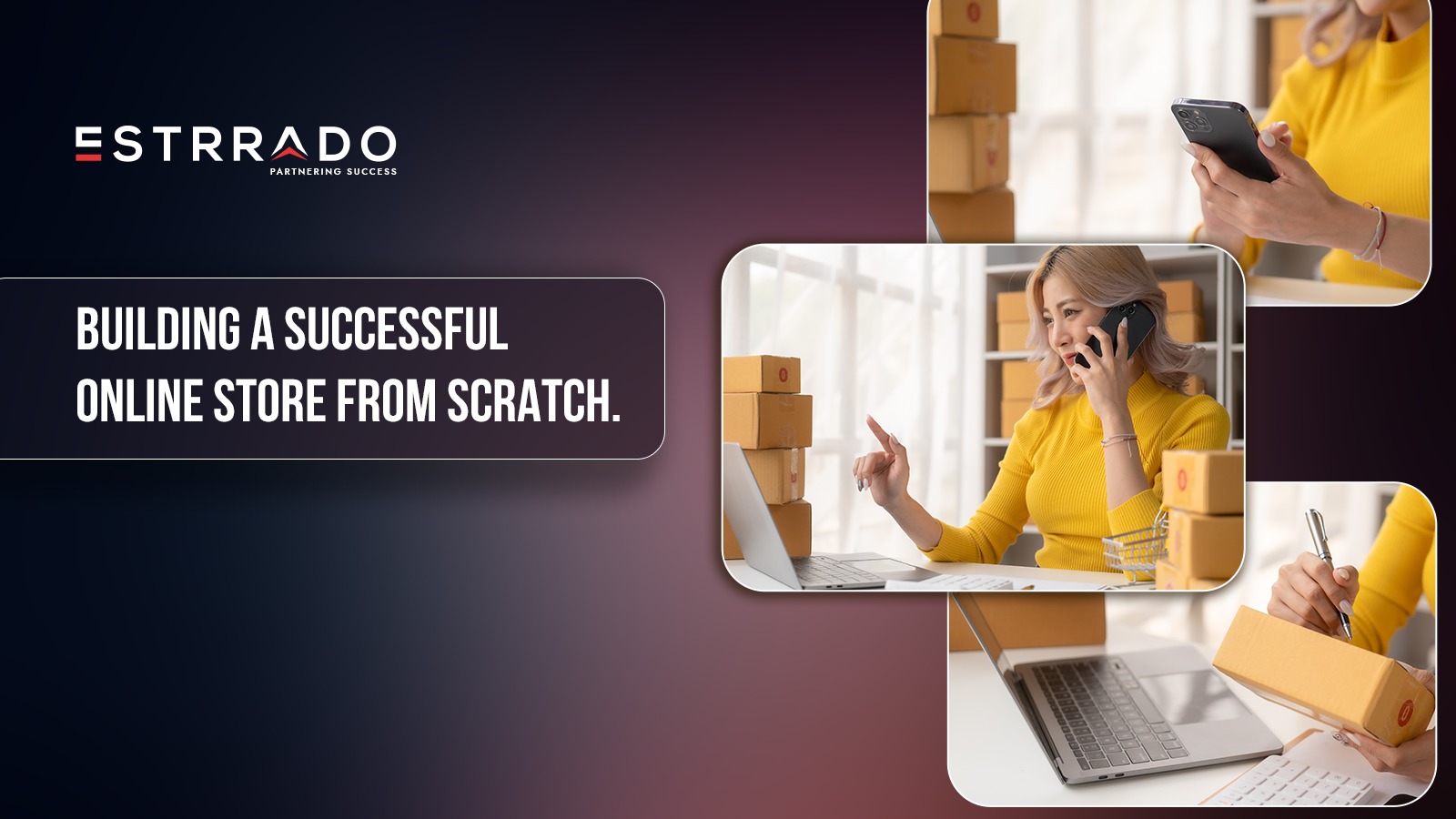Introduction E-Commerce Website Development
Electronic commerce refers to buying and selling products and services online or via electronic means. E-commerce has revolutionised how people conduct businesses and consumers shop, as transactions are seamless and can occur effortlessly worldwide.
Benefits of Online Store
E-commerce has significantly grown in today’s technology-driven world. Whether you are thinking of starting an online or looking to expand, here are some benefits that are sure to help you decide:
- Businesses can reach a broader customer base, expanding globally without worrying about the limitations of physical stores.
- Customers can shop anytime, anywhere since online stores are available 24/7, increasing convenience and accommodating schedules.
- Running an online store has lower operational costs than physical stores, allowing businesses to save on rent, utilities and staff.
- E-commerce platforms offer valuable, real-time insights through transactions and site visits, enabling personalised marketing, improved customer relationships and informed decisions.
- Online stores allow businesses to interact with customers directly to obtain feedback and reviews. Customers can also get customer support anytime with live messaging and chatbots.
- E-commerce platforms help businesses stay ahead in the competitive landscape. Online stores can scale with a company’s changes, adapting to increased demand without infrastructure changes.
Preparing for E-Commerce Ventures
The first step is to lay a proper foundation. Thorough research and identifying niche opportunities are vital. Gather information on the particular industry, customer preferences, trends, competition and overall market demand. A niche opportunity is an unexplored or underrated area. It’s a specific area where there is potential to offer unique products or services that cater to a particular group of customers with specific needs or preferences.
Based on the above, create a business plan detailing the market analysis, funding, unique value proposition, marketing and sales strategy, operational plan, products or services offered and the implementation timeline. Remember, a business plan should be updated and reviewed as your business grows.
There are two main models in E-commerce: B2B (Business to Business) and B2C (Business to Consumer). Choosing between the two involves the nature of your products or services, your target audience, the complexity of your sales process, and your business goals.
Building the Foundation: Technical Essentials
Website Development: From Wireframes to Launch
When building an online store, an important aspect is picking the domain name. Choose a name that is easy to remember, relevant to your business and ideally reflects your brand’s identity. Decide on the domain extension(.org, .com, .net, etc.) and register!
Now, you can start designing your website.
Start by creating wireframes, which are basic sketches or layouts representing the website’s structure. They are simple and don’t focus on design aesthetics. Next comes the prototypes. Prototypes are more functional and interactive, allowing you to demonstrate how different elements work together.
After finalising the prototype, you can move on to the visual aspects of the website, such as typography, colour palette, images and overall aesthetic and style. Then comes the development, where you start coding your website based on the prototype and design. You’ll also integrate any necessary back-end functionality, like forms, databases, and user authentication.
Throughout the development process, test your website on different devices and browsers. Fixing bugs, glitches, and inconsistencies occurs during this stage.
Designing a User-Centric Online Store
Customers are the backbone of any successful business. Therefore, design an online store that puts the needs and convenience of the customers at the forefront.
Responsive Design
Responsive web design focuses on creating websites that adapt and respond to various devices seamlessly. Two key aspects that responsive web design addresses are optimising User Experience (UX) and User Interface (UI). UX design focuses on giving users a meaningful and effortless shopping experience, while UI design focuses on how users interact with the visual elements.
High-Quality Visuals
First impressions matter. The product images are the first thing customers notice, which needs to be high-quality. Using high-quality visuals also instils trust in customers by letting them know you value transparency and quality.
Detailed Product Descriptions
While images give visual information, product descriptions offer the necessary context and details. Provide detailed and persuasive descriptions that convince customers to make a purchase. Both these aspects should align with your brand identity and resonate with the target audience.
Secure Payment
Integrating secure payment gateways and prioritising customer data privacy through SSL (Secure Sockets Layer) certification are essential in building trust and ensuring a safe online shopping experience for your e-commerce customers. An SSL certificate encrypts the communication between your website and the customer’s browser. This encryption prevents hackers and malicious actors from intercepting or tampering with data exchanged during the browsing and checkout process.
Product Reviews and Ratings
Highlighting product reviews and ratings enhances customer satisfaction and foster a positive e-commerce experience. They provide credibility to your products, offer transparency and can improve your website’s search engine optimisation.
Customer Service and Return Policies
Maintain customer satisfaction and loyalty through 24/7 customer support and returns. Provide accessible customer support channels such as live chat, email, and a customer service hotline. Clearly outline your return and refund policies and make the process as simple as possible.
Navigating E-commerce Platforms
When setting up an e-commerce website, one of the decisions you’ll need to make is whether to use a self-hosted e-commerce platform or a hosted e-commerce platform.
Self-Hosted E-commerce Platforms:
Pros:
- Self-hosted platforms provide more flexibility for customisation.
- You have greater control over your website’s hosting environment, security measures, and overall performance optimisation.
- With proper management, you can scale your self-hosted website as your business grows.
Cons:
- Self-hosted platforms require a certain level of technical knowledge to set up, maintain, and troubleshoot issues.
- You’ll need to invest in web hosting, domain registration, security measures, and potentially development or design services.
- Building and maintaining a self-hosted website can be time-consuming.
Hosted E-commerce Platforms:
Pros:
- Hosted platforms offer simplified setup processes that require minimal technical knowledge.
- Maintenance is typically handled by the platform, reducing your responsibilities.
- Hosted platforms often have lower initial costs since they bundle hosting and general features in their subscription plans.
Cons:
- Hosted platforms may have limitations on customisation.
- You have less control over the hosting environment and server-side configurations.
- While many hosted platforms offer scalability, there might be limitations.
Leveraging Content Marketing
Crafting informative and shareable content is a powerful strategy to enhance your online presence, drive traffic, engage your audience and contribute to your overall marketing efforts.
To make the most of your content, here are a few tips:
- Identify your audience and goals
- Create content that interests your audience, such as guides, tutorials, industry trends and updates.
- Optimise for SEO
- Be consistent
- Promote your content
- Engage with your audience
- Evolve and adapt by tracking performance
The Power of Social Media in E-commerce
Utilising social media platforms for brand building and running effective paid advertising campaigns are essential components of a comprehensive digital marketing strategy for your e-commerce business. Social media offers a dynamic and interactive way to connect with your audience, build brand awareness, and foster customer engagement. Paid advertising allows you to target specific audiences and promote your products directly.
Scaling Your E-commerce Business
Strategies that can significantly contribute to the success and longevity of your e-commerce business include:
Analysing sales data and identifying growth opportunities
Expanding your product range and diversifying revenue streams
Analysing sales data provides valuable insights into customer’s behaviour, preferences, and trends. Expanding your product range and diversifying your revenue streams can help you tap into new markets, increase customer retention, and create more stable business growth.
International E-commerce Considerations
While international expansions can open up new revenue streams and a broader customer base, it also requires careful planning and consideration.
Cultural differences, regulatory compliance, language barriers, logistics and shipping and currency fluctuations are some challenges of exploring global markets. Thorough research, strategic planning, and adaptability will help you navigate these challenges and flourish in international markets.
E-commerce Analytics and Tracking
Setting up Google Analytics for e-commerce insights is a valuable step in understanding how users interact with your e-commerce website and optimising your online business. Google Analytics provides a wealth of data to help you make informed decisions and improve your e-commerce performance.
Once you’ve set up Google Analytics with e-commerce tracking, you can start monitoring key metrics, such as conversion rate, return on investments, revenue and sales, product performance, etc.
Future Trends in E-commerce
Technology is continuously evolving. Two major trends in use include the use of AI and chatbots for customer support and the integration of Augmented Reality (AR) for virtual shopping.
AI-powered chatbots are revolutionising customer support in the e-commerce industry. They offer real-time assistance, streamline communication, and provide personalised interactions, improving customer satisfaction and operational efficiency.
AR technology is reshaping the way customers interact with products online. By overlaying digital information in the real world, AR provides immersive and interactive shopping experiences, allowing customers to try virtually before a purchase.
Conclusion
The world of e-commerce offers opportunities to connect with customers, expand your reach, and build a successful business. Every endeavour has its ups and downs. Remember, a successful business begins with a plan and a commitment to take action. So seize the opportunity, take action, and start building your online store today! Schedule a free consultation with a consultant for e-commerce development.
Frequently Asked Questions E-Commerce Website Development
1) How do I start building my online store from scratch?
To start building your online store, follow these steps:
- Choose which products or services to provide.
- Select a domain name and register it.
- Choose an e-commerce platform.
- Design your store’s layout and branding.
- Add products, product descriptions, and images.
- Set up payment gateways and shipping options.
- Test your website thoroughly before launching.
2)Which e-commerce platform should I choose?
The choice of platform depends on your technical skills, budget, and desired features. Some popular options include Shopify, WooCommerce, Magneto and Estrrado.
3)Do I need technical skills to set up an online store?
While technical skills can be helpful, many e-commerce platforms offer user-friendly interfaces that require little to no coding knowledge. However, some basic understanding of website management can be beneficial.
4)What ongoing maintenance does my online store need?
Regularly update product information, monitor inventory levels, maintain security patches, and optimise the website for performance. Additionally, gather and respond to customer feedback to improve the user experience.
5)How do I optimise my online store for search engines (SEO)?
Implement on-page SEO techniques, such as optimising product descriptions, meta tags, and URLs. Create valuable content, build backlinks, and ensure your website is mobile-responsive for better search engine rankings.








